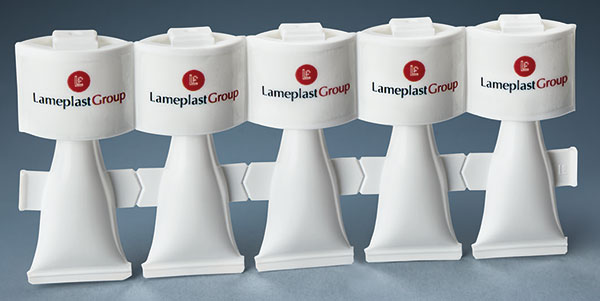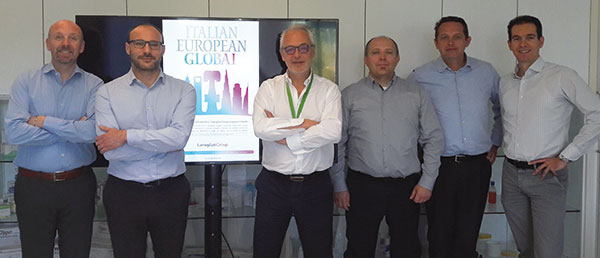The true challenge? To surpass oneself
“The present is the indivisible limit that separates the past from the future” (1). This seems to be a conviction of Lameplast Group’s Enrico Folchini, the new CEO of the Modena based leader in the preparation, filling and packaging of pharmaceuticals, medical and cosmetic devices, who is working on having his company make a qualitative leap. Stefano Lavorini
(1) Henri Bergson, philosopher

The new monodose strip, that Lameplast presented at the Paris Pharmapack exhibition: more room for printing and inserting product information.
Lameplast Group means production of plastic containers, mondose strips, bottles, droppers (Lameplast), the supply of single-fill filling machines (under the Pentafill brand), also production and filling services for third parties, product development and research for pharmaceuticals and medical devices (COC Pharmaceuticals) and, of course, full-range consulting at the service of major brands in the cosmetics and pharmaceutical industries.
A reality that, thanks to the enthusiasm and vision of the founding members - Giovanni Ferrari, Evro Fabbri and Antonio Fontana - has always been a good example of entrepreneurial vision and commitment to creating economic and social value in the area where the company is rooted, and with which it has been able to share perspectives and developments.
The same willpower, the same confidence in the future as well as the sincere bond with its employees, convinced the three shareholders, in April 2016, to sell the entire company share to Aksìa Group SGR SpA, an independent private equity firm, with the aim of ensuring company continuity.
Curious to understand the meaning and perspectives of the operation, we met Enrico Folchini - a Venetian by birth but Ferrarese by adoption, a man of great experience, 25 years spent in the packaging industry - called upon to head this “jewel”.

The management board. From left to right: Marco Albasini (Operations Manager COC Farmaceutici), Luca Loschi (Sales Manager), Enrico Folchini (CEO), Flavio Lamoure (Chief Financial Officer), Luca Iulli (Operations Manager Lameplast and Pentafill), Diego Bulgarelli (Director of Lf of America).
The sale of the group was an operation that did not totally surprise us, also because it is consistent with the founder’s biography. After a year, what has changed?
In first place, I would like to point out that Aksìa is an Italian, rather Milanese investment fund with three partners, that has been operating on the market since ‘97. This fund carries out mergers & acquisitions, but unlike many others, also operations, or that is investments to increase the value of companies over a period of about five to seven years.
With this approach, it has decided to focus on the pharmaceutical industry, because in Italy, despite low growth rates on the domestic market, healthy and sound companies operate; indeed Aksia has done so by acquiring Lameplast Group, one of the few if not the only full service integrated companies that has knowledge and expertise ranging from primary packaging to the finished product.
My adventure began on October 3, 2016, after having gained 25 years of experience in various multinational companies in the industry: more than a decade in Pelliconi, then in Helvoet Pharma (now Datwyler Sealing Solution) and finally in the Essentra group. During my career I have held several roles, from project manager to research and development director, to CEO, with world-class experiences, including the acquisition of companies.
I was chosen by Aksìa also probably because I have my ideas, my business vision, so much so that we have already clarified what the means and strategies to follow are. In this sense it is very important to be able to rely on a proprietor such as Aksìa, with a strong propensity to invest and grow.


A growth by internal means, but also by external acquisitions? With what goals?
In forty years many things have come to pass, proven among other things by the group’s consolidated turnover of 45 million in 2016; Well, in the next six, seven years, we intend to replicate this path. This is my personal goal: already for the current year, we expect growth both in terms of turnover and Ebitda ...
I cannot go into details, but the intention is to reach beyond the borders of Europe, aiming at a greater internationalization of our activities.
But not only that. We have defined different business models, starting with that for the Italian and European markets, aiming - in continuity with the work of Giovanni Ferrari - to bring the Lameplast group back to the levels of dynamism of just a few years ago.
Lameplast’s presence in the United States is a different matter, and implies transferring production directly to that market (nowadays marginally served by Italy), regardless of the “Trump phenomenon”.
Notwithstanding Lameplast is recognized for its quality, service and availability, we want to be evermore a benchmark and point of reference for our customers. Which is why we have to create more innovation, systematically proposing new ideas and products. With this goal in mind, we have better articulated the company, creating an independent “product development” function, which reports directly to me.


Hence it is a true and proper R&D center, which goes beyond product customisaton?
Obviously, there are customers who express specific demands to which we need to be able to provide effective responses, but it is a kind of innovation that arises from the reaction to a stimulation or request. Personally, however, I think it is crucial to field a proactive product development, thus offering the market solutions that are always original, anticipating needs.
By the end of 2016 the monodose accounted for 60% of Lameplast’s production; not by chance we are the leader in Italy, but to maintain this market share today we must absolutely renew and reinvigorate our packaging, working on the characteristics of the materials and on various possibilities of end use of the containers.
To grow, therefore, we need to intercept and interpret emerging needs, but also to better preside over markets where we are still marginal, in Europe and in the world.
In actual fact, do you have anything new to report?
In February 2017, we presented a new monodose strip at the Paris Pharmapack exhibition, which offers more room for printing and inserting product information.
In Europe and in the US regulations require the presence of product information on each container, in addition to those commonly indicated on the secondary packaging and/or on the package leaflets. It’s a way to increase product safety, making the product always recognizable.
We have thus developed a proprietary patented closure system on both sides of the cap, which can accommodate data such as composition, posology, expiration date and/or other indications of use, using tampographic printing or ink-Jet, Datamatrix, QR code, labels, embossed bracelets, Braille writing, without compromising the practicality and ease of use of the monodose dispensing system and without the risk of interfering with the content itself.
Among the main benefits, the highest protection of the product, as there is no risk of migration of ink or adhesive through plastic as well as a 20% reduction in size compared to containers with equal capacity.
As I said, I really believe in product development, but the same thing applies to COC, or that is to the pharmaceutical company of the group: at this moment we have four projects underway aimed at modifying the pharmaceutical form of certain products - from solid to liquid, for example - so as to extend the possibility of using and enhancing the pluspoints of our containers.
The work was started at the beginning of 2017, and we expect to already present the first results in mid 2018.
But not only that. Up to now, the construction of filling machines (read Pentafill) has always been considered to help the spread of the monodose. This activity is going to grow in importance, proof of this being the fact we will shortly launch a very innovative machine that will complete the current range, specifically designed to fill monodose containers in a sterile environment. Let it be understood, we do not intend to compete with the big guns in the industry, but focus on a market segment that requires average-to-low production levels. In other words, we want to offer more opportunity to all limited-sized companies with high added value products, even if they do not want to outsource filling operations.
Has something changed in terms of organization in order to achieve this “new course”? Have you made any interventions in regard to the staff?
Before my arrival, Lameplast was a fast running train; my challenge is to make it go even faster. I have therefore decided to concentrate some functions: as is the case with financial and control activities that, for Lameplast and COC, were separate.
Interventions that are not easy, which change the rules of the game. And for this reason I have called in a trusted person, Flavio Lamoure, with whom I have worked in the past, achieving good results.
I have also created an internal management board, composed of five people, in addition to me: Marco Albasini (Director of Operations COC Farmaceutici), Luca Loschi (Sales Manager), Flavio Lamoure (Chief Financial Officer), Luca Iulli (Operations Manager Lameplast and Pentafill), Diego Bulgarelli (Director of Lf of America). Specifically, on a commercial level, we are increasingly focusing on business development, so we now have people who deal with current business and others who have the task of developing new business. Everyone has their own task. There are then two project managers, one that follows all the activities of Lameplast, hence packaging and machinery, and the other specialized in COC’s activity.
Lastly, the number of employees will stay the same. We have explicitly asked staff to collaborate as much as possible on change.
There are though questions of efficiencies that need to be consolidated, particularly with regard to packaging production, in terms of changing the manufacturing mindset. Let it be clear: I intend to increase production efficiency not to reduce staff, but to be more competitive on the market and increase business.
All told, it seems to me that there are the conditions to ensure that continuity of enterprise that has always been the primary goal of the founders.
As said, the acquisition of the group by Aksia brings with it the need for growth to be achieved within a time limit of a few years. In this regard, I will be happy to give myself fully, but I am convinced that things cannot be done alone; we need a communion of activities, knowledge, sharing, goals, because no single person ever makes the company. Whoever has the “hand on the tiller” counts to the extent that they take into consideration the people who count.
He must be able to take the right risks, bearing in mind that market times are getting faster: it is utopian to think of making 100% safe choices.
In fact, if you want to be first and have a competitive advantage, you have to hurry up, not just in product but also service innovation. Faster and faster!

















